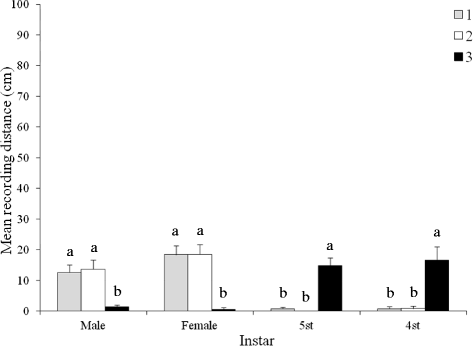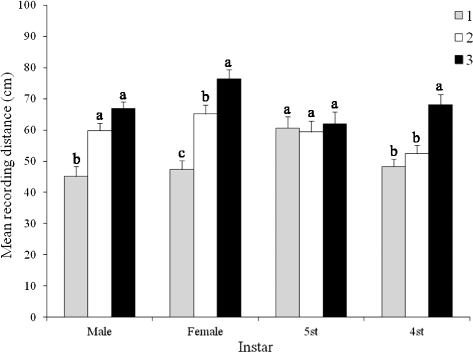Volatile compound diversity and conserved alarm behaviour in Triatoma dimidiata
- PMID: 25656170
- PMCID: PMC4324405
- DOI: 10.1186/s13071-015-0678-8
Volatile compound diversity and conserved alarm behaviour in Triatoma dimidiata
Abstract
Background: Triatoma dimidiata (Latreille) is a key vector complex of Trypanosoma cruzi, etiologic agent of Chagas disease, as it spans North, Central, and South America. Although morphological and genetic studies clearly indicate existence of at least five clades within the species, there has been no robust or systematic revision, or appropriate nomenclature change for species within the complex. Three of the clades (haplogroups) are distributed in Mexico, and recent evidence attests to dispersal of clades across previously "presumed" monotypic geographic regions. Evidence of niche conservatism among sister species of this complex suggests that geographic dispersal is possible for non-sympatric populations, although no information is available on the behavioural aspects of potential interclade interactions, for instance whether differentiation of chemical signaling or response to these signals could impede communication among the haplogroups.
Methods: Volatiles emitted by disturbed bugs, Brindley's (BGs), and metasternal (MGs) glands were identified using solid-phase micro-extraction (SPME) and gas chromatography coupled mass spectrometry (GC-MS). Volatile compounds emitted by BGs and MGs, and those secreted by disturbed nymphs and adults, of the three Mexican T. dimidiata haplogroups were tested for avoidance behaviour by conspecific nymphs and adults using an olfactometer.
Results: Triatoma dimidiata haplogroups all have three age-related alarm responses: absence of response by early stage nymphs, stage-specific response by 4-5th stage nymphs, and a shared 4-5th nymph and adult response to adult compounds. Disturbed bugs released 15 to 24 compounds depending on the haplogroup, among which were three pyrazines, the first report of these organoleptics in Triatominae. Isobutyric acid from BGs was the most abundant molecule in the response in all haplogroups, in addition to 15 (h1) to 21 (h2 and h3) MG compounds. Avoidance behaviour of disturbed bugs and volatiles emitted by BGs were haplogroup specific, while those from the MG were not.
Conclusions: Discriminant and cluster analysis of BG + MG compounds indicate significant separation among the three haplogroups, while alarm response compounds were similar between h2 and h3, both distinct from h1. This latter haplogroup is ancestral phylogenetically to the other two. Our results suggest that alarm responses are a conserved behaviour in the Triatoma dimidiata complex.
Figures






Similar articles
-
"Sweeter than a rose", at least to Triatoma phyllosoma complex males (Triatominae: Reduviidae).Parasit Vectors. 2018 Feb 17;11(1):95. doi: 10.1186/s13071-018-2677-z. Parasit Vectors. 2018. PMID: 29454375 Free PMC article.
-
Chemical communication in Chagas disease vectors. Source, identity, and potential function of volatiles released by the metasternal and Brindley's glands of Triatoma infestans adults.J Chem Ecol. 2006 Sep;32(9):2035-52. doi: 10.1007/s10886-006-9127-7. Epub 2006 Aug 11. J Chem Ecol. 2006. PMID: 16902820
-
Volatile compounds emitted by Triatoma dimidiata, a vector of Chagas disease: chemical analysis and behavioural evaluation.Med Vet Entomol. 2013 Jun;27(2):165-74. doi: 10.1111/j.1365-2915.2012.01056.x. Epub 2012 Dec 3. Med Vet Entomol. 2013. PMID: 23205718
-
Antennal phenotype of Mexican haplogroups of the Triatoma dimidiata complex, vectors of Chagas disease.Infect Genet Evol. 2016 Jun;40:73-79. doi: 10.1016/j.meegid.2016.02.027. Epub 2016 Feb 26. Infect Genet Evol. 2016. PMID: 26921798
-
Triatoma dimidiata (Latreille, 1811): a review of its diversity across its geographic range and the relationship among populations.Infect Genet Evol. 2007 Mar;7(2):343-52. doi: 10.1016/j.meegid.2006.10.001. Epub 2006 Nov 13. Infect Genet Evol. 2007. PMID: 17097928 Review.
Cited by
-
Does Trypanosoma cruzi (Chagas, 1909) (Kinetoplastida: Trypanosomatidae) modify the antennal phenotype of Triatoma dimidiata (Latreille, 1811) (Hemiptera: Triatominae)?Parasit Vectors. 2022 Dec 14;15(1):466. doi: 10.1186/s13071-022-05587-y. Parasit Vectors. 2022. PMID: 36517855 Free PMC article.
-
Odor characterization of the poultry red mite (Dermanyssus gallinae) for identification of volatile biomarkers of infestation across multiple commercial laying hen systems.Poult Sci. 2025 Jun;104(6):105101. doi: 10.1016/j.psj.2025.105101. Epub 2025 Mar 25. Poult Sci. 2025. PMID: 40158286 Free PMC article.
-
Electrophysiological Responses of Eighteen Species of Insects to Fire Ant Alarm Pheromone.Insects. 2019 Nov 14;10(11):403. doi: 10.3390/insects10110403. Insects. 2019. PMID: 31739452 Free PMC article.
-
"Sweeter than a rose", at least to Triatoma phyllosoma complex males (Triatominae: Reduviidae).Parasit Vectors. 2018 Feb 17;11(1):95. doi: 10.1186/s13071-018-2677-z. Parasit Vectors. 2018. PMID: 29454375 Free PMC article.
-
Genetic variation and phylogeography of the Triatoma dimidiata complex evidence a potential center of origin and recent divergence of haplogroups having differential Trypanosoma cruzi and DTU infections.PLoS Negl Trop Dis. 2019 Jan 28;13(1):e0007044. doi: 10.1371/journal.pntd.0007044. eCollection 2019 Jan. PLoS Negl Trop Dis. 2019. PMID: 30689662 Free PMC article.
References
-
- Schofield CJ. Evolución y control del Triatoma dimidiata. In: Organización Panamericana de la Salud, editor. Taller para el establecimiento de pautas técnicas en el control de Triatoma dimidiata. San Salvador: Organización Panamericana de la Salud; 2002. p. 12–8. (Document OPS/HCP/HCT/214/02).
-
- Bargues MD, Klisiowicz DR, González-Candelas F, Ramsey JM, Monroy C, Ponce C, et al. Phylogeography and genetic variation of Triatoma dimidiata, the main Chagas disease vector in Central America, and its position within the genus Triatoma. PLoS Negl Trop Dis. 2008. doi:10.1371/journal.pntd.0000233 - PMC - PubMed
-
- Grisales N, Triana O, Angulo V, Jaramillo N, Parra-Henao G, Panzera F, et al. Diferenciación genética de las tres poblaciones colombianas de Triatoma dimidiata (Latreille, 1811) mediante análisis molecular del gen mitocondrial ND4. Biomedica. 2010;30:207–14. doi: 10.7705/biomedica.v30i2.184. - DOI - PubMed
Publication types
MeSH terms
Substances
LinkOut - more resources
Full Text Sources
Other Literature Sources
Miscellaneous

